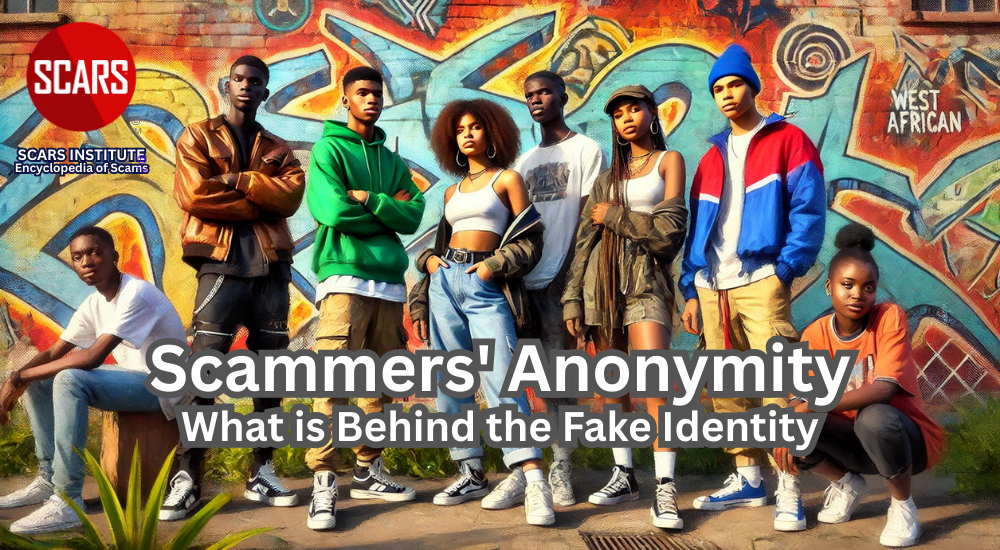Scammer Anonymity – What is Behind the Fake Identity
Behind the Mask: What Scammer Identities Reveal—and Conceal—About the Scammer’s Mind and Personality
How Scammers Operate – A SCARS Institute Insight
Authors:
• Tim McGuinness, Ph.D., DFin, MCPO, MAnth – Anthropologist, Scientist, Director of the Society of Citizens Against Relationship Scams Inc.
• Vianey Gonzalez B.Sc(Psych) – Psychologist, Certified Deception Professional, Psychology Advisory Panel & Director of the Society of Citizens Against Relationship Scams Inc.
Article Abstract
Scammers construct false identities not as expressions of their true selves but as strategic tools designed to manipulate and control. Victims often assume they’ve glimpsed a scammer’s authentic personality, but the reality is far more calculated. These personas are built with precision—tailored stories, emotional cues, and practiced performances—to bypass defenses and exploit trust. Some scammers, especially in West African networks, rotate roles as part of coordinated teams, while others, particularly from Latin America, the Philippines, or Eastern Europe, may use real elements of their identity to create a convincing illusion.
In Southeast Asia, many scammers operate under coercion in trafficking rings, adding another layer of complexity. Regardless of the scammer’s origin or method, what victims experience is a rehearsed performance—one meant to harvest emotional and financial gain. Understanding this helps victims see the mask for what it is: not a reflection of character, but a shield used to deceive. For advocates, recognizing these patterns allows for more informed, compassionate, and effective support in helping victims rebuild trust in themselves and others.

Behind the Mask: What Scammer Identities Reveal—and Conceal—About the Scammer’s Mind and Personality
In the aftermath of online scams, victims often ask a haunting question: Who was I really talking to? The person they came to trust—or even love—turns out to be a fabrication. And when the mask falls, another question emerges: Was that fake identity a reflection of the scammer’s true self? The answer is complex, rooted in psychology, behavior theory, and the darker realities of criminal manipulation.
It may be tempting to think that the scammer’s false identity reveals some hidden part of their authentic self. After all, when no one is watching, don’t people show who they really are? But the psychology behind impersonation and deception tells a different story. In most cases, the fake persona isn’t an expression of inner truth—it is a psychological tool, carefully constructed to exploit others while protecting the scammer from moral consequences.
As tempting as it may be to believe you know them, you know less about your scammer(s) than you think!
Anonymity Doesn’t Reveal the True Self—It Removes Accountability
Scammers thrive on invisibility. Anonymity isn’t liberating in a moral sense; it’s disinhibiting. In the absence of consequences, many people will behave in ways that contradict their public values. This is a phenomenon well-documented in psychology. Known as deindividuation, it describes the way individuals in anonymous or group settings often engage in behavior they would normally avoid—aggression, deceit, cruelty—because they feel unidentifiable and unaccountable.
For impersonation scammers, this anonymity is intentional. They don’t just hide behind fake names or images. They build entirely false personas, often with consistent narratives, detailed backstories, and emotional hooks tailored to their victims. These identities are not projections of a repressed personality. They’re tools designed to manipulate, control, and exploit.
The Role of Dissociation: How Scammers Separate Themselves from Their Actions
To sustain a long-term deception, many scammers rely on dissociation—a psychological defense mechanism that allows a person to mentally distance themselves from the reality of their actions. This enables them to maintain two parallel selves: one that commits the fraud and another that remains untouched by guilt or emotional consequence.
This is not unlike how some con artists or cult leaders operate. They create a psychological buffer between their real identity and the lies they tell. Over time, this can lead to compartmentalization, where the scammer rationalizes their behavior as just a “job” or a “game,” insulating themselves from empathy or remorse.
When the Fake Identity Becomes a Performance, Not a Revelation
Scammers don’t use false identities to express something authentic. They use them to perform. The persona they create is engineered to gain trust, extract resources, and avoid detection. In many cases, especially within organized criminal groups, these identities are not personal at all—they’re templates. Scripts. Modules of manipulation get reused across hundreds of victims.
Romance scammers, for example, often rotate through a limited set of archetypes: the deployed soldier, the lonely widower, the successful businessman stranded overseas. These roles are not chosen because they reflect the scammer’s personality—they are chosen because they work. They target specific emotional vulnerabilities. The more convincing the performance, the more likely the scammer will succeed.
This performance mindset is reinforced by culture and community in some scamming circles. In parts of the world where financial fraud has become normalized or even celebrated, scammers view their work as clever, not criminal. They bond over their “successes,” compete for bigger payouts, and view victims as marks, not people. The identity they assume is no more personal than a mask worn for a heist.
The Team Behind the Persona: How Scammers in West Africa Specialize and Trade Off Roles
In many West African-based scams, especially romance scams, victims are not interacting with a single scammer. These operations often function as structured teams or loosely organized networks, where different individuals play specialized roles depending on the stage of the scam. One scammer may initiate contact and build rapport, while another—often more skilled in emotional manipulation—takes over to deepen the relationship. A third might step in when it’s time to create a crisis, such as a fabricated medical emergency or a business problem that requires money.
This rotation serves multiple purposes. It allows scammers to work in shifts across time zones and maintain the illusion of constant availability. It also maximizes the psychological impact on the victim, as each scammer specializes in a specific type of engagement—flirtation, sympathy, urgency, or persuasion. The persona remains consistent, but the voice behind it may change multiple times, often without the victim noticing.
Understanding this helps explain the high level of emotional sophistication and consistency victims experience, even over long periods. It also underscores the deliberate, strategic nature of the scam. This isn’t improvisation—it’s a coordinated operation. For victims, this knowledge can be painful but empowering. It clarifies that the bond they felt was not just one person’s deception but the output of an organized effort to defraud them. It wasn’t intimacy—it was a performance, rehearsed and executed by a team.
When Real Identities Are Used: Scammers from Latin America, the Philippines, and Eastern Europe
In contrast to the highly anonymized and team-driven approach of West African scam operations, scammers from regions such as Latin America, the Philippines, Ukraine, and Russia often use their real names, images, and personal details as part of the deception. In these cases, the scammer may share real photos, true facts about their life, and even engage through live video chats. This creates a powerful illusion of authenticity and emotional closeness.
But even when the details are factual, the narrative is still a performance. These scammers craft their interactions around a carefully managed persona designed to hook, hold, and exploit the victim. The use of real identity components does not signal honesty—it signals confidence. These individuals believe they can maintain control of the interaction, often because the victim has already been emotionally compromised.
By blending truth with performance, these scammers make it more difficult for the victim to detect deception. The emotional authenticity the victim perceives is a deliberate illusion, not a sign of mutual intimacy. This hybrid method—where the scammer reveals personal truths to build rapport while simultaneously manipulating—can be especially damaging, as it causes the victim to question not just the scam, but their own ability to judge sincerity.
Scams from Southeast Asia: Victims of Circumstance and Instruments of Control
A growing number of scams trace back to scam centers in Southeast Asia—particularly in countries like Cambodia, Myanmar, and Laos—where scammers may be trafficked or coerced into working under exploitative conditions. These individuals often operate under surveillance, with quotas to meet and limited freedom to disengage from the criminal enterprise.
While these scammers also use scripted personas and false identities, they may reveal traces of their real emotional state in private chats, especially over time. Some express despair, exhaustion, or fear. Others hint at their captivity or seek sympathy in subtle ways. However, this does not always negate the damage being done. Even when the scammer is a coerced participant, the manipulation remains real and the victim’s losses and emotional harm remain profound.
For victims, learning that their scammer may have also been exploited can create conflicting emotions—anger, compassion, and confusion. But regardless of the scammer’s personal circumstances, the deception must be addressed, and the trauma processed. Understanding that scams from this region often involve layered exploitation—of both victim and scammer—adds a necessary dimension to prevention, law enforcement, and recovery strategies.
Do Any Elements of the Real Self Show Through?
It’s important to acknowledge that even in performance, some psychological tendencies may emerge. A scammer who exhibits prolonged manipulation, emotional cruelty, or sadism may indeed be expressing darker aspects of their personality. But this is not the same as saying the fake identity is who they “really are.”
Instead, what you see is what the scammer is capable of when they believe there are no consequences. In that sense, the behavior reflects more about their moral boundaries than their hidden identity. Some may take pleasure in control or domination. Others may simply feel nothing. But in most cases, the scammer’s behavior says more about their relationship to power and empathy than about any authentic self longing for expression.
The Predator Analogy: Why the Mask Makes Them More Dangerous
Comparing scammers to predators is not exaggeration. Predatory behavior often thrives in anonymity. The fake identity functions like camouflage. It allows the scammer to get close to the victim, bypass defenses, and exploit vulnerabilities without being seen for who they really are.
But unlike natural predators, scammers typically have full cognitive awareness of what they’re doing. They choose their targets carefully. They study human behavior. They manipulate with intention. The persona they wear doesn’t free them to be themselves—it enables them to behave without conscience.
This is why many victims report a chilling realization: the person they thought they knew was meticulously engineered to mirror their hopes and needs. That isn’t a reflection of truth—it’s the result of calculated design. The scammer was not revealing a version of their true self. They were studying the victim in order to impersonate the person the victim most wanted to find.
The Illusion of Emotional Reciprocity
Victims often form real emotional bonds with the scammer’s persona. This is part of what makes recovery so difficult. The love felt, the connection experienced, and the intimacy shared were genuine on the victim’s side. So it’s natural to wonder whether the scammer, at any point, felt something too.
In most cases, the answer is no. Any appearance of emotional investment is part of the manipulation. Scammers often mirror language, adopt tone, and mimic emotional cues. This is not emotional expression. It is emotional strategy. The goal is control.
There are exceptions. In rare cases, scammers may develop conflicted feelings, especially in prolonged one-on-one scams. But these moments are usually fleeting and do not override the exploitative nature of the relationship. The underlying motive remains financial or psychological gain, not mutual connection.
Helping Victims Understand What the Mask Really Is
For advocates, therapists, or support professionals working with scam victims, helping the victim understand the function of the false identity is critical. Many victims feel foolish or humiliated for believing in the persona. They may ask, “How could I not have known?”
It’s important to reframe the experience. The victim didn’t fail to see the truth because they were blind. They failed because the scammer deliberately engineered a lie to be indistinguishable from the truth. The manipulation was deliberate, strategic, and psychologically sophisticated.
Helping victims grasp that the scammer’s false identity was a weapon—not a confession—can support the grieving process. It allows the victim to separate the emotional reality of their experience from the fraud that created it. This separation is key to restoring trust in themselves and rebuilding their own identity.
What Advocates Should Remember
Advocates should remember that scammers are not misunderstood romantics hiding behind a mask. They are opportunists. The identity they present is not a revelation of truth—it’s a calculated deception crafted for exploitation. Viewing it through that lens helps professionals avoid inadvertently romanticizing the scam or minimizing its harm.
When you explain that the scammer’s behavior was driven by tactics, not truth, you help restore clarity to the victim’s experience. And when you reinforce that the victim’s emotions were real, even if the scammer’s were not, you affirm the victim’s humanity and support emotional closure.
Conclusion: The Mask Is Not a Window, It’s Armor
The scammer’s false identity is not a window into who they truly are. It is armor. It is a mechanism of control. It conceals their true intentions, protects them from scrutiny, and enables them to act without empathy. What it reveals is not the scammer’s soul, but their strategy.
Understanding this distinction helps victims detach from the illusion and start healing. It also strengthens the advocate’s ability to support recovery with clarity and compassion. When we stop asking what the fake identity meant about the scammer, and start focusing on what it did to the victim, we shift the narrative back to truth, accountability, and healing.
-/ 30 /-
What do you think about this?
Please share your thoughts in a comment below!
Article Rating
Table of Contents
- Behind the Mask: What Scammer Identities Reveal—and Conceal—About the Scammer’s Mind and Personality
- Article Abstract
- Behind the Mask: What Scammer Identities Reveal—and Conceal—About the Scammer’s Mind and Personality
- Anonymity Doesn’t Reveal the True Self—It Removes Accountability
- The Role of Dissociation: How Scammers Separate Themselves from Their Actions
- When the Fake Identity Becomes a Performance, Not a Revelation
- The Team Behind the Persona: How Scammers in West Africa Specialize and Trade Off Roles
- When Real Identities Are Used: Scammers from Latin America, the Philippines, and Eastern Europe
- Scams from Southeast Asia: Victims of Circumstance and Instruments of Control
- Do Any Elements of the Real Self Show Through?
- The Predator Analogy: Why the Mask Makes Them More Dangerous
- The Illusion of Emotional Reciprocity
- Helping Victims Understand What the Mask Really Is
- What Advocates Should Remember
- Conclusion: The Mask Is Not a Window, It’s Armor
RATE THIS ARTICLE?
LEAVE A COMMENT?
Recent Comments
On Other Articles
- Nikolaus on Dating Scammers Paradise: Ivory Coast: “The Ivory Coast romance scam is still going on. It seems that local authorities don’t handle the issue effectively!” Dec 10, 02:17
- on The SCARS Institute Top 50 Celebrity Impersonation Scams – 2025: “Thank you – we will.” Dec 7, 11:41
- on The SCARS Institute Top 50 Celebrity Impersonation Scams – 2025: “You should add Sean Bean to your list of Celebrities. This one is very good, and persistent. He will be…” Dec 2, 12:07
- on How You Think & Talk About Your Scam Affects Your Recovery: “I have hung on to the scams for far too long. With the intervention of an all-merciful God, I have…” Nov 6, 22:13
- on Disengaging From A Fake Scam Relationship: “Taci, you may want to join our new support community at www.SCARScommunity.org” Nov 6, 03:01
- on Disengaging From A Fake Scam Relationship: “This particular article helped me discover the many things I did wrong the first time I was scammed. I should…” Nov 5, 22:49
- on About the SCARS RomanceScamsNOW.com Website – 24 Years Published: “It was unavailable for a few days, but it is available again. If he would be interested, he is welcome…” Nov 5, 00:59
- on About the SCARS RomanceScamsNOW.com Website – 24 Years Published: “My husband has been scammed and your classes have been helping him but now he can’t seem to access them.…” Oct 26, 14:57
- on Talia Shepard – Impersonation Victim – Stolen Photos – 2024: “Hi, I’m Patrick from Belgium and I found this site by chance, so I just got to know it, and…” Oct 17, 23:46
- on Talia Shepard – Impersonation Victim – Stolen Photos – 2024: “Hallo ik ben Patrick uit Belgie en het is in verband over PayPal. Ik heb het dit jaar spijtig genoeg…” Oct 17, 23:08
ARTICLE META
Important Information for New Scam Victims
- Please visit www.ScamVictimsSupport.org – a SCARS Website for New Scam Victims & Sextortion Victims
- Enroll in FREE SCARS Scam Survivor’s School now at www.SCARSeducation.org
- Please visit www.ScamPsychology.org – to more fully understand the psychological concepts involved in scams and scam victim recovery
If you are looking for local trauma counselors please visit counseling.AgainstScams.org or join SCARS for our counseling/therapy benefit: membership.AgainstScams.org
If you need to speak with someone now, you can dial 988 or find phone numbers for crisis hotlines all around the world here: www.opencounseling.com/suicide-hotlines
A Note About Labeling!
We often use the term ‘scam victim’ in our articles, but this is a convenience to help those searching for information in search engines like Google. It is just a convenience and has no deeper meaning. If you have come through such an experience, YOU are a Survivor! It was not your fault. You are not alone! Axios!
A Question of Trust
At the SCARS Institute, we invite you to do your own research on the topics we speak about and publish, Our team investigates the subject being discussed, especially when it comes to understanding the scam victims-survivors experience. You can do Google searches but in many cases, you will have to wade through scientific papers and studies. However, remember that biases and perspectives matter and influence the outcome. Regardless, we encourage you to explore these topics as thoroughly as you can for your own awareness.
Statement About Victim Blaming
Some of our articles discuss various aspects of victims. This is both about better understanding victims (the science of victimology) and their behaviors and psychology. This helps us to educate victims/survivors about why these crimes happened and to not blame themselves, better develop recovery programs, and to help victims avoid scams in the future. At times this may sound like blaming the victim, but it does not blame scam victims, we are simply explaining the hows and whys of the experience victims have.
These articles, about the Psychology of Scams or Victim Psychology – meaning that all humans have psychological or cognitive characteristics in common that can either be exploited or work against us – help us all to understand the unique challenges victims face before, during, and after scams, fraud, or cybercrimes. These sometimes talk about some of the vulnerabilities the scammers exploit. Victims rarely have control of them or are even aware of them, until something like a scam happens and then they can learn how their mind works and how to overcome these mechanisms.
Articles like these help victims and others understand these processes and how to help prevent them from being exploited again or to help them recover more easily by understanding their post-scam behaviors. Learn more about the Psychology of Scams at www.ScamPsychology.org
Psychology Disclaimer:
All articles about psychology and the human brain on this website are for information & education only
The information provided in this article is intended for educational and self-help purposes only and should not be construed as a substitute for professional therapy or counseling.
While any self-help techniques outlined herein may be beneficial for scam victims seeking to recover from their experience and move towards recovery, it is important to consult with a qualified mental health professional before initiating any course of action. Each individual’s experience and needs are unique, and what works for one person may not be suitable for another.
Additionally, any approach may not be appropriate for individuals with certain pre-existing mental health conditions or trauma histories. It is advisable to seek guidance from a licensed therapist or counselor who can provide personalized support, guidance, and treatment tailored to your specific needs.
If you are experiencing significant distress or emotional difficulties related to a scam or other traumatic event, please consult your doctor or mental health provider for appropriate care and support.
Also read our SCARS Institute Statement about Professional Care for Scam Victims – click here to go to our ScamsNOW.com website.


















Thank you for your comment. You may receive an email to follow up. We never share your data with marketers.